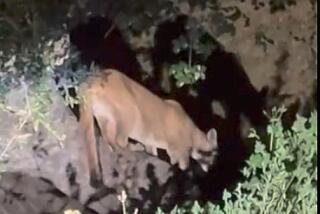Rhino left with no place to hide
Reporting from Johannesburg, South Africa — She has a bullet in her face, another in her leg and every reason not to trust humans.
But when Johannesburg Zoo rhino keeper Alice Masombuka calls her name, the wild black rhino flutters her ears delicately and stands alert, gazing in the direction of the voice.
“Hey Phila, Phila! Hey big girl, good girlie. Phila!” says Masombuka, leaning against the fence, her singsong voice floating irresistibly in Johannesburg’s damp spring air.
Phila takes a few steps, hesitates, stops, changes her mind, takes a few more steps and halts again fearfully.
“Look, she wants to come,” coos Masombuka.
Then, as curious and brave as a foal, the rhino trots to the fence.
The first time Phila was shot by poachers, during the soccer World Cup in July, the bones in her foot were shattered, and she took a bullet behind the shoulder. Another rhino was slaughtered and her horn taken off. Then, six weeks ago, Phila was shot at least nine times; one of the rounds tore through her nasal cavity and left her bleeding for weeks.
Poaching for the Chinese and Vietnamese markets, where the horns are believed to have medicinal qualities, has slashed the black rhino population from 70,000 in the late 1960s to 4,000 today. About 1,500 are in South Africa, many in private reserves that have to meet strict criteria.
About 120 rhinos were poached in South Africa last year. This year the number shot up, and it is expected to reach about 300 by year’s end. A group of veterinarians was arrested recently on suspicion that they were involved in the trade. But the poaching incidents go on: Another rhino is killed almost every day.
After the first shooting, Phila’s owner had the 5-year-old rhino transferred from his reserve to a supposedly secure enclosure on a different property in the northern province of Limpopo. Her horn was removed to discourage poachers, and she spent several months recovering.
Then came the second attack.
She was in an enclosure, called a boma, of about 10,000 square feet, with a fence of closely spaced poles.
“Days before she was due to be released, these guys came back. And for 45 minutes they stalked around the outside of the boma, shooting at her like a fish in a barrel, in the dark,” said the owner, who asked to be identified only by his first name, Allan, because of concerns about the safety of rhinos on the reserve where he breeds the animals.
Panic-stricken, Phila dashed around the boma, crashing into the fence and trees, as the poachers fired at her head. They were willing to kill her for the stump of her sawn-off horn.
When police trackers and helicopters arrived, they found no trace of the criminals.
When he received word of the attack from his farm manager, Allan said he felt dead inside.
“You feel sick to the stomach. You actually feel totally empty. What can you do about something that you took all the best steps to prevent — and it’s happened?”
He thinks the word “poachers” is too mild to describe the criminal syndicates involved in the business.
“While rhinos have got horns and it’s a desirable product, they’re on their way to extinction. They’re gone,” he said. “How do you get over this greed, and the criminality that goes with it?”
Allan is an unusual rancher, a shy crusader and environmentalist alarmed by the harm humans do to the planet. He doesn’t keep the animals for profit through safari tourism, but for his love of the animal. His breeding program was his own small contribution to saving a species.
“Where is the payback? Why bother? What’s in it for me? The short answer is that I needed to have black rhino mainly because it was the right thing to do,” he says. It was difficult when he started in 1998 to persuade his wife and children to let rhinos onto the farm; they wouldn’t be able to just walk or ride horses around the farm like they used to.
After the second attack on Phila, Allan didn’t know where to turn, terrified an insider might leak details of her whereabouts. He finally found what he hoped would be a secure location — with guards — but in October, two helicopters flew low over the boma. (Some poaching gangs use choppers to attack.)
“When I heard that, I said to the zoo, ‘Please, you have got to take this animal.’ ”
Phila (her name means life in Zulu) will be at the Johannesburg Zoo until she recovers, probably less than a year, after which Allan hopes to bring her home.
Under treatment at the zoo, she has regained the hearing in one ear. But she still has a bullet in her nasal passage and one in a leg. She’s lost so much weight that her ribs poke out and her legs are as skinny as sticks.
At first, Phila was afraid of the zoo peacocks’ cries, the passing groups of schoolchildren and the white rhinos in the next enclosure, who peered at the newcomer. (In the wild, black rhinos are solitary creatures but white rhinos often live in herds.) But slowly, she’s making progress.
“She’s doing fine, eating like a horse,” says Masombuka, “and less nervous of people.”
Masombuka savors the hours she spends each day bonding with Phila. (Masombuka’s already on rump-scratching terms with the white rhinos and trunk-kissing terms with the elephants.)
“She has no trust of people. I have to win her trust. I spend a lot of time with her. She has to see me a lot.
“I call ‘Phila, Phila, come girlie,’ and she’ll look around. When I’m giving her food, I call her so that she will associate me with something to eat and she’ll know I’m not there to harm her, I’m there to take care of her.”
The zoo’s veterinarian, Brett Gardner, says taming her will make it easier to examine and treat her. But she will lose her trust of humans rapidly once she is released.
For now, “she’s a very frightened animal, but she wants to come. She wants to,” Masombuka says. “But there’s this barrier.”
Masombuka is in no hurry: Caring for the rhino, she says, is like looking after her own daughter. She’s just waiting for the day Phila takes food from her hand.
“That day, I’ll be the happiest person in the zoo. I’ll be so excited, I’ll want to shout it out to everyone — that Phila has arrived.”
More to Read
Sign up for Essential California
The most important California stories and recommendations in your inbox every morning.
You may occasionally receive promotional content from the Los Angeles Times.










